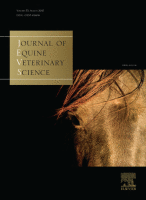Ver ítem
- xmlui.general.dspace_homeCentros e Institutos de InvestigaciónCICVyA. Centro de Investigación en Ciencias Veterinarias y AgronómicasInstituto de VirologíaArtículos científicosxmlui.ArtifactBrowser.ItemViewer.trail
- Inicio
- Centros e Institutos de Investigación
- CICVyA. Centro de Investigación en Ciencias Veterinarias y Agronómicas
- Instituto de Virología
- Artículos científicos
- Ver ítem
Molecular characterization of equine rotavirus group A detected in Argentinean foals during 2009–2014
Resumen
Equine rotavirus group A (RVA) has been detected in several countries worldwide since its first detection in 1975. Currently, equine RVA is considered the major cause of dehydrating diarrhea in foals younger than 3 months, and the frequency of detection in clinical cases varies from 20% to 77%. The genotypes of epidemiologic relevance found in horses are G3P [12] and G14P[12]. In a survey conducted in Argentina from 1992 to 2008, equine RVA was detected
[ver mas...]
Equine rotavirus group A (RVA) has been detected in several countries worldwide since its first detection in 1975. Currently, equine RVA is considered the major cause of dehydrating diarrhea in foals younger than 3 months, and the frequency of detection in clinical cases varies from 20% to 77%. The genotypes of epidemiologic relevance found in horses are G3P [12] and G14P[12]. In a survey conducted in Argentina from 1992 to 2008, equine RVA was detected in 21% and 39% of the fecal samples and outbreaks, respectively. Genotype distribution was 51% G3P[12] and 33% G14P[12]. In continuation with the surveillance, the aim of the present study was to characterize the equine RVA detected in Thoroughbred
foals in Argentina from 2009 to 2014. A total of 436 stool samples (corresponding to 177 single diarrhea cases or outbreaks) were analyzed. Equine RVA was detected in 31% (135 of 436) of the samples, which corresponded to 42% (74 of 177) of outbreaks. From the positive cases, 42% (57 of 135) were genotyped. Of this, 63% were G3 (36 of 57) and 37% (21 of 57) were G14 genotype. Considering the whole data (1992–2014), equine RVA was detected in 25% (300 of 1,207) of the stool samples and 41% (119 of 293) of the diarrhea outbreaks. The results of this study also show a cyclic pattern of the G3 and G14 prevalence in the horse
population with a change in G3:G14 frequencies from year to year. Furthermore, clustering in the phylogenetic tree suggests evolutionary and geographic relationships between the Argentinean strains compared with the strain circulating worldwide.
[Cerrar]

Fuente
Journal of Equine Veterinary Science 59 : 64-70 (December 2017)
Fecha
2017-12
ISSN
0737-0806
Formato
pdf
Tipo de documento
article
Palabras Claves
Derechos de acceso
Restringido
 Excepto donde se diga explicitamente, este item se publica bajo la siguiente descripción: Creative Commons Attribution-NonCommercial-ShareAlike 2.5 Unported (CC BY-NC-SA 2.5)
Excepto donde se diga explicitamente, este item se publica bajo la siguiente descripción: Creative Commons Attribution-NonCommercial-ShareAlike 2.5 Unported (CC BY-NC-SA 2.5)

